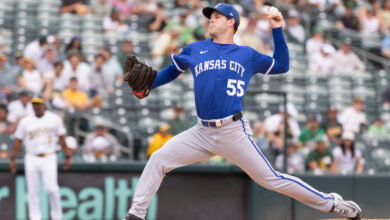
Cubs Farm System Ranked One of Least Valuable Based on Projections
It’s been well known for some time now that the Cubs no longer have a great farm system. Once the envy of baseball, their incredible depth of elite talent has been culled by promotions, trades, and a disappointing lack of pitching development. So now as the Cubs look to bolster a group they feel is still title-worthy, they may be forced to do so with trades that involve members of the 25-man roster.
Again, this is far from a new concept and it’s not something that has impacted the Cubs at the big league level yet. Well, not to a great degree. And given how wide open their competitive window remains, the front office isn’t necessarily concerned with the dearth of their prospects.
“I kind of laugh when people start to criticize the state of the farm system because the entire goal of a farm system is not to win Midwest League championships or Southern League championships or PCL championships,” Theo Epstein explained in July of 2017. “The goal of the farm system is to get your players to the big league level so that they can win a world championship and take some of your prospects and trade them for big league players so you can win championships.
“The best part of our farm system right now is at the lower levels, where the talent is emerging, and at the big leagues, where they’re all wearing rings.”
Of course, that was nearly a year and a half ago and not much has changed in terms of the location of the talent. Nico Hoerner is receiving rave reviews from everyone who watches him and Erick Leal has hosted quite the coming-out party during the Arizona Fall League season, but neither has played above A-ball yet. Adbert Alzolay was shut down due to injury and there don’t appear to be many other impact bats in the system.
In fact, the only thing remarkable about the Cubs system at this point is just how low it ranks in terms of overall value. Craig Edwards of FanGraphs’ reviewed the “number of players each team has at each grade level from 40 (where there are nearly 500 players) all the way up to 70, where Vlad Guerrero Jr. sits all alone” in order to put together a comprehensive ranking of all 30 organizations.
As you can see from the tables below, the Cubs come in near the bottom in terms of both projected WAR and the resultant dollar value of those wins. Only five teams (Seattle, Boston, Baltimore, Kansas City, Arizona) are below the Cubs, according to Edwards.

There’s a lot to unpack when it comes to the methodology of prospect valuation and how Edwards (or anyone, for that matter) is able to put a dollar value on these players, particularly those who are lower in the rankings. It’s far too much for our time here, so I’d advise you to click on those two links if you’d like to provide yourself with more robust context for the subject matter. Your common sense may work as well, totally up to you.
As for the main thrust of this particular column, we’re just going to focus on where the Cubs stand in general. It was noted above that only one 70-grade prospect exists in these rankings, though one must assume that number would be higher were so many players not dinged for being the sons of Poughkeepsie plumbers. Suffice to say the Cubs have no such highly-rated prospects.
Nor can they lay claim to any of the three 65-grade prospects. Or any of the 15 who carry a 60 grade. But surely the Cubs have one of the 26 players with a score of 55? Nope. They do, however, boast three players at 50, six more at 45, and a fairly impressive 18 at graded as 40. So all told, the Cubs’ total of 27 prospects in this exercise comes in 14th.
The problem, at least in terms of this particular ranking, is that those players only project out to 10.4 total post-2018 WAR. That’s just a half-game more than Javy Baez and Ben Zobrist combined for this past season, so not exactly a great outlook when you’re talking about 27 total potential careers. For what it’s worth — and it’s worth about $458 million by Edwards’ estimation — the Padres have 46 prospects who figure to put up 50.9 WAR.
That’s the bad news. The good news is that these valuations are far from perfect and could change drastically with the breakout of one or two players. What if Hoerner blossoms into the Cubs’ second baseman of the future and starts putting up 5-WAR seasons starting in 2020? Or if Leal, Alzolay, or any number of other currently overlooked pitchers suddenly becomes an ace?
You could even take it a step further and consider a reliever like Dakota Mekkes, who, while not prone to big WAR numbers due to his role, could be an integral part of the bullpen. And though we are quite a ways removed from Epstein’s comments above, he’s talking about a group that was never expected to develop overnight. The Cubs microwaved their early draft picks and then set up a bunch of Crock Pots to slow-cook scores of others.
Even though the reviews haven’t been great recently, we’re still going to have to wait a while to see the final results. So take these rankings with a healthy pinch of salt and keep the lid on a little longer. Or, you know, feel free to throw up your arms in disgust over the state of the farm system. The outcome will remain the same either way.
What say you, though, dear reader: Are these rankings indicative of some cracks in the foundation of the Cubs’ success or are they just far too premature to reveal anything other than the subjective nature of early evaluations?

